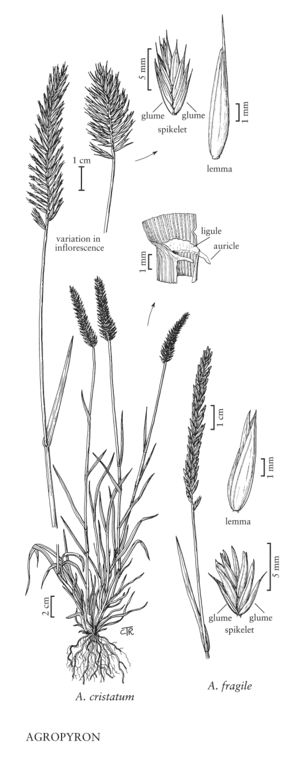Difference between revisions of "Agropyron fragile"
FNA>Volume Importer |
FNA>Volume Importer |
||
| Line 7: | Line 7: | ||
|synonyms={{Treatment/ID/Synonym | |synonyms={{Treatment/ID/Synonym | ||
|name=Agropyron sibiricum | |name=Agropyron sibiricum | ||
| − | |authority= | + | |authority= |
| + | |rank=species | ||
}} {{Treatment/ID/Synonym | }} {{Treatment/ID/Synonym | ||
|name=Agropyron mongolicum | |name=Agropyron mongolicum | ||
| − | |authority= | + | |authority= |
| + | |rank=species | ||
}} {{Treatment/ID/Synonym | }} {{Treatment/ID/Synonym | ||
|name=Agropyron fragile var. sibiricum | |name=Agropyron fragile var. sibiricum | ||
| − | |authority= | + | |authority= |
| + | |rank=variety | ||
}} {{Treatment/ID/Synonym | }} {{Treatment/ID/Synonym | ||
|name=Agropyron cristatum subsp. fragile | |name=Agropyron cristatum subsp. fragile | ||
| − | |authority= | + | |authority= |
| + | |rank=subspecies | ||
}} | }} | ||
|hierarchy=Poaceae;Poaceae subfam. Pooideae;Poaceae tribe Triticeae;Agropyron;Agropyron fragile | |hierarchy=Poaceae;Poaceae subfam. Pooideae;Poaceae tribe Triticeae;Agropyron;Agropyron fragile | ||
| Line 29: | Line 33: | ||
-->{{Treatment/Body | -->{{Treatment/Body | ||
|distribution=Colo.;N.Mex.;Utah;Mont.;Wyo.;Alta.;B.C.;Man.;N.W.T.;Sask.;Yukon;Nev.;S.Dak. | |distribution=Colo.;N.Mex.;Utah;Mont.;Wyo.;Alta.;B.C.;Man.;N.W.T.;Sask.;Yukon;Nev.;S.Dak. | ||
| − | |discussion=<p>Agropyron fragile is native from the southern Volga basin through the Caucasus to Turkmenistan and Mongolia. It is more drought-tolerant than A. cristatum. Within the Flora region, A. fragile appears to be uncommon outside of experimental plantings. This may change as more cultivars become available.</p> | + | |discussion=<p><i>Agropyron fragile</i> is native from the southern Volga basin through the Caucasus to Turkmenistan and Mongolia. It is more drought-tolerant than <i>A. cristatum</i>. Within the Flora region, <i>A. fragile</i> appears to be uncommon outside of experimental plantings. This may change as more cultivars become available.</p> |
|tables= | |tables= | ||
|references= | |references= | ||
| Line 38: | Line 42: | ||
-->{{#Taxon: | -->{{#Taxon: | ||
name=Agropyron fragile | name=Agropyron fragile | ||
| − | |||
|authority=(Roth) P. Candargy | |authority=(Roth) P. Candargy | ||
|rank=species | |rank=species | ||
| Line 46: | Line 49: | ||
|family=Poaceae | |family=Poaceae | ||
|illustrator=Cindy Roché | |illustrator=Cindy Roché | ||
| + | |illustration copyright=Utah State University | ||
|distribution=Colo.;N.Mex.;Utah;Mont.;Wyo.;Alta.;B.C.;Man.;N.W.T.;Sask.;Yukon;Nev.;S.Dak. | |distribution=Colo.;N.Mex.;Utah;Mont.;Wyo.;Alta.;B.C.;Man.;N.W.T.;Sask.;Yukon;Nev.;S.Dak. | ||
|reference=None | |reference=None | ||
| Line 51: | Line 55: | ||
|publication year= | |publication year= | ||
|special status= | |special status= | ||
| − | |source xml=https:// | + | |source xml=https://jpend@bitbucket.org/aafc-mbb/fna-data-curation.git/src/f50eec43f223ca0e34566be0b046453a0960e173/coarse_grained_fna_xml/V24/V24_398.xml |
|subfamily=Poaceae subfam. Pooideae | |subfamily=Poaceae subfam. Pooideae | ||
|tribe=Poaceae tribe Triticeae | |tribe=Poaceae tribe Triticeae | ||
Revision as of 20:20, 16 December 2019
Plants not rhizomatous. Culms 30-100 cm, rarely geniculate. Ligules to 1 mm; blades 1.5-6 mm wide. Spikes (5)8-15 cm long, 5-13 mm wide, linear to narrowly lanceolate; internodes 1.5-5 mm. Spikelets 7-16 mm, appressed or diverging up to 30(35)° from the rachises. Glumes 3-5 mm, glabrous or hairy, often awned, awns 1-3 mm; lemmas 5-9 mm, keels scabrous distally, apices unawned, sometimes mucronate, mucros up to 0.5 mm; anthers 4-5 mm. 2n = (14), 28, (42).
Distribution
Colo., N.Mex., Utah, Mont., Wyo., Alta., B.C., Man., N.W.T., Sask., Yukon, Nev., S.Dak.
Discussion
Agropyron fragile is native from the southern Volga basin through the Caucasus to Turkmenistan and Mongolia. It is more drought-tolerant than A. cristatum. Within the Flora region, A. fragile appears to be uncommon outside of experimental plantings. This may change as more cultivars become available.
Selected References
None.
